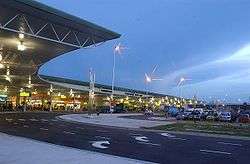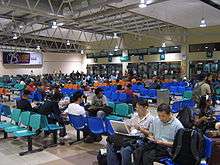Low-cost carrier terminal
Low-cost carrier terminal or LCCT a.k.a. budget terminal is a specific type of airport terminal designed with the needs of low-cost airlines in mind. Though terminals may have differing charges and costs, as is common in Europe, the concept of an all-budget terminal was promoted and pioneered by Tony Fernandes of AirAsia at Kuala Lumpur International Airport in 2006.[1]
Description


In some cases, the designs of a low-cost carrier terminal mimic old designs of an airport terminal, such as the former airport of Hong Kong, Kai Tak Airport. With a stripped-down airport terminal, airports can reduce daily operating costs significantly, thereby passing along the savings to budget airlines and ultimately their passengers. It specifically entails cost reductions from normal airports in terms of:
- Physical building:
- forgoing expensive architectural design for simple boxy warehouse-like design.
- low ceilings.
- foregoing steel and glass structures to reduce air conditioning overhead cost.[2]
- Amenities:
- may have less choice in terms of restaurants and duty-free shops.
- decoration may be mostly airline ads.
- Support structures:
- long corridors, moving walkways, and jet bridges often replaced by transport with airport buses and boarding with airstairs. (This also allows quicker plane turnaround time,[3] which may lower landing fee, and increase aircraft utilization).
- Baggage handling is much simplified, e.g. some LCCTS lack Baggage carousels.
However these terminals may also have modern facilities such as free Wi-Fi, and be comfortably air conditioned. A German study (Swanson 2007) of costs showed that at Malaysia's KLIA and Changi LCCTs, airlines were charged roughly 2/3 to 3/4 the total cost of landing at the main terminal; for budget-sensitive carriers, any savings advantage can be critical.[4]
Klia2 billed as the world's largest purpose-built terminal dedicated to low-cost carriers, is designed to cater for 45 million passengers a year with future capacity expansion capability. Built at a cost of US$1.3 billion, klia2 started commercial operations on May 2, 2014 at the Kuala Lumpur International Airport (KLIA) in Malaysia.
Realisation of the projects
While the concept of a simple basic terminal in theory would lower costs, in practice, it can be turned into a pork barrel project such as klia2.
When klia2 was first proposed MAHB said it would cost MYR2 billion, a figure that was later revised to MYR2.6 billion. Then came news that the terminal would cost MYR4 billion, double the original estimate. Now there’s talk that the bill could go as high as MYR5 billion. That makes no sense – the low-cost terminal will now cost much more than KLIA. Yes, I asked for a new terminal but one that has simple facilities. Did it have to cost 20 times our present LCCT?
— Tony Fernandes, on klia2.
Budget terminals also have to consider if they only serve budget airlines or all airlines. In this way, a terminal can essentially "lose its budget identity".[1] In the case of Macau airport, "from an airport perspective, having a separate LCCT is frequently more expensive than having one terminal for all carrier types because of the need to duplicate services and systems including check-in, security and immigration." [1] In the case of KLIA2, Malaysia Airports has instructed Airasia in 2016 that the overbudget terminal isn't a LCCT terminal at all.[5]
List of existing/expanding budget terminals
Europe









.svg.png)











Asia & Oceania
.svg.png)









North & South America



List of proposed budget terminals





.svg.png)


References
- "Low cost airport terminals still popular in Asia Pacific but declining in significance in Europe". Retrieved 10 August 2015.
- Mukherjee, Sharmistha (5 July 2014). "Centre to focus on low-cost airports along tourist circuits". Business Standard India. Retrieved 23 April 2018 – via Business Standard.
- http://www.fzt.haw-hamburg.de/pers/Scholz/ALOHA/ALOHA_PUB_DLRK_09-09-08.pdf
- http://www.fzt.haw-hamburg.de/pers/Scholz/arbeiten/TextLunTan.pdf
- "Malaysia Airports quashes AirAsia's LCCT2 plans - Nation - The Star Online". www.thestar.com.my. Retrieved 23 April 2018.
- "New low cost terminal inaugurated at Marseille - Aviation24.be". Retrieved 10 August 2015.
- "Les vols low cost et régionaux ont désormais leur nouveau hall à l'aéroport Toulouse-Blagnac". ladepeche.fr (in French). Retrieved 2020-06-15.
- "TERMINAL F LAUNCH. A NOTICE FOR PASSENGERS". Boryspil Airport. 2019-03-28. Retrieved 2019-05-12.
- "Soekarno-Hatta Airport Set to Open Indonesia's First Low-Cost Carrier Terminal".
- Chris Cooper (5 April 2012). "Tokyo's Narita to Build Low-Cost Carrier Terminal by 2015". Bloomberg.com. Retrieved 10 August 2015.
- "Airport executives mull new terminal for low-cost flights". Retrieved 10 August 2015.
- "Local News". Sun.Star. Retrieved 10 August 2015.
- "The Moscow Times - News, Business, Culture & Multimedia from Russia". The Moscow Times. Retrieved 10 August 2015.
- "Central Japan International Airport president: LCCT could enter service in 1H2013". Retrieved 10 August 2015.
- "Airport expansion would separate FIFO, budget travellers". Brisbane Times. 2013-06-17. Retrieved 10 August 2015.
- "Gov't plans to build low-cost terminal near NAIA-3". ABS-CBN News. Retrieved 10 August 2015.
- "Archived copy". Archived from the original on 2013-11-26. Retrieved 2013-11-26.CS1 maint: archived copy as title (link)
External links
- Foo Sek Min, Civil Aviation Authority of Singapore (16 June 2006). "A budget terminal for budget airlines". International Airport Review.
- Jacobs Consultancy (11 May 2007). "REVIEW OF DEDICATED LOW-COST AIRPORT PASSENGER FACILITIES" (PDF).
- Richard Rowe (16 Nov 2007). "Budget buildings: the rise of low-cost terminals". Flightglobal.
- Richard De Neufville, MIT (February 2008). "Low-Cost Airports for Low-Cost Airlines: Flexible Design to Manage the Risks". Transportation Planning and Technology. 31: 35–68. doi:10.1080/03081060701835688.